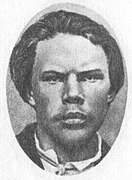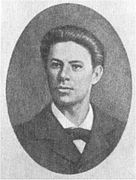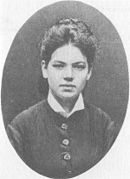
Assassination of Alexander II of Russia
On 13 March [O.S. 1 March] 1881, Alexander II, the Emperor of Russia, was assassinated in Saint Petersburg, Russia while returning to the Winter Palace from Mikhailovsky Manège in a closed carriage.
Date
13 March 1881
Near the Catherine Canal, Saint Petersburg
Alexander II of Russia, Ignacy Hryniewiecki, Alexander Maleichev, Nikolai M. Zakharov, and possibly others.
Members of Narodnaya Volya
Nitroglycerin and piroxylin bombs
The assassination was planned by the Executive Committee of Narodnaya Volya ("People's Will"), chiefly by Andrei Zhelyabov. Of the four assassins coordinated by Sophia Perovskaya, two of them actually committed the deed. One assassin, Nikolai Rysakov, threw a bomb which damaged the carriage, prompting the Tsar to disembark. At this point a second assassin, Ignacy Hryniewiecki, threw a bomb that fatally wounded Alexander II.
Alexander II had previously survived several attempts on his life, including the attempts by Dmitry Karakozov and Alexander Soloviev, the attempt to dynamite the imperial train in Zaporizhzhia, and the bombing of the Winter Palace in February 1880. The assassination is popularly considered to be the most successful action by the Russian nihilist movement of the 19th century.
On 25–26 August 1879, on the anniversary of his coronation, the 22-member Executive Committee of Narodnaya Volya resolved to assassinate Alexander II in the hopes that it would precipitate a revolution.[1][2] Over the subsequent year and a half, the various attempts on Alexander's life had ended in failure. The Committee then decided to assassinate Alexander II on his way back to the Winter Palace following his usual Sunday visit to the Mikhailovsky Manège. Andrei Zhelyabov was the chief organizer of the plot. The group had observed his routines for a couple of months and was able to deduce the alternate intentions of the entourage. They found that the Tsar would head for home either by going through Malaya Sadovaya Street or by driving along the Catherine Canal. If by the Malaya Sadovaya, the plan was to detonate a mine placed under the street. To further ensure the success of the plot, four bomb-throwers were to loiter at the corners of the street; after the explosion, all of them were to close in on the Tsar and use their bombs if necessary. If, in contrast, the Tsar passed by the canal, the bomb-throwers alone were to be relied upon. Ignacy Hryniewiecki (Ignaty Grinevitsky), Nikolai Rysakov, Timofey Mikhailov, and Ivan Yemelyanov had volunteered as bomb-throwers.[3][1]
The group opened a cheese store in the Eliseyev Emporium on Malaya Sadovaya Street, and used one of the rooms to dig a tunnel extending to the middle of the street, where they would lay large quantities of dynamite. The hand-held bombs were designed and manufactured chiefly by Nikolai Kibalchich. The night before the attack, Perovskaya along with Vera Figner (also one of seven women on the Executive Committee) helped assemble the bombs.[1][2]
Zhelyabov was to have directed the bombing, and he was supposed to assail Alexander II with dagger or pistol in case both the mine and the bombs were unsuccessful. When Zhelyabov was arrested two days prior to the attack, his wife Sophia Perovskaya took the reins.[4]
Aftermath for Jews[edit]
Alexander II was seen as tolerant towards Jews. During his reign, special taxes on Jews were eliminated and those who graduated from secondary school were permitted to live outside the Pale of Settlement, and became eligible for state employment. Large numbers of educated Jews moved as soon as possible to Moscow, Saint Petersburg, and other major cities.[18][19] Alexander III, who succeeded his father after his assassination, reversed this trend.
The importance of Hesya Helfman's role in the assassination was undetermined, and her Jewish origins stressed.[20][21] Another conspirator, Ignacy Hryniewiecki, was also rumoured to be Jewish, though there seems to have been no basis for this. In the aftermath of the assassination, the May Laws were passed. The assassination also inspired retaliatory attacks on Jewish communities. During these pogroms, thousands of Jewish homes were destroyed; many families were reduced to poverty and large numbers of men, women and children were injured or killed in 166 towns in the south-western provinces of the Empire









